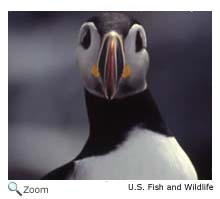Diet
The Atlantic puffin dives for its food and uses its wings to swim underwater. It dives both from the air and from the surface of the water and can dive hundreds of feet under the water in pursuit of prey. It catches small fish, crustaceans, and mollusks and usually swallows them underwater.
Life Cycle
 The puffin nests in small colonies. The male uses his bill and feet to dig a nesting burrow on an ocean cliff or island. The nest is lined with grass. The nest may also be made in a rocky crevice. The female lays a single egg and both parents incubate the egg by tucking it under a wing and leaning against it. The egg hatches in about 40 days, and both parents feed the chick for another 40 days. The adult Atlantic puffin can carry as many as 30 small fish in its bill to feed to its chick. Male and female pairs may mate for more than one season.
The puffin nests in small colonies. The male uses his bill and feet to dig a nesting burrow on an ocean cliff or island. The nest is lined with grass. The nest may also be made in a rocky crevice. The female lays a single egg and both parents incubate the egg by tucking it under a wing and leaning against it. The egg hatches in about 40 days, and both parents feed the chick for another 40 days. The adult Atlantic puffin can carry as many as 30 small fish in its bill to feed to its chick. Male and female pairs may mate for more than one season.
Behavior
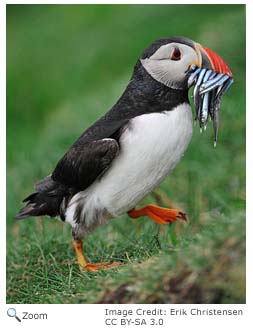 The Atlantic puffin is one of four species of puffins and is the only puffin that lives in the North Atlantic Ocean. It is sometimes known as the "sea parrot" or the "clown of the sea" because of its colorful and comical appearance.
The Atlantic puffin is one of four species of puffins and is the only puffin that lives in the North Atlantic Ocean. It is sometimes known as the "sea parrot" or the "clown of the sea" because of its colorful and comical appearance.
The Atlantic puffin is well adapted for life in the water. It is an excellent diver and swimmer. Its compact body, strong wings, and webbed feet help it dive and maneuver under the water. While the puffin is agile in the water, it is not as graceful in the air and on land! It often crash lands both on the water and on land.

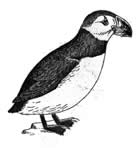
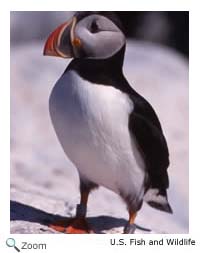
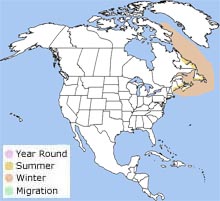 The Atlantic puffin breeds along the Atlantic Coast from the Canadian Maritimes south to Maine.
The Atlantic puffin breeds along the Atlantic Coast from the Canadian Maritimes south to Maine.
